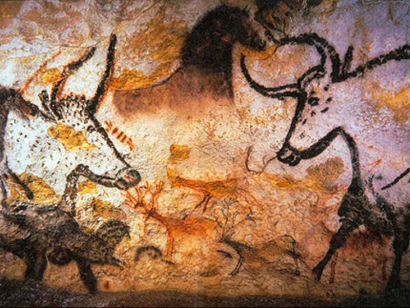
Photo: Wikimedia Commons
According to research, public speaking is one of our greatest fears, up there with spiders, death and heights. Because of this, when faced with having to give a presentation, many of us simply focus on how to get through it while making his few mistakes as possible.
The trouble with this approach is that it leads to uninspired presentations — with the audience looking at their watches and wondering when it will end. The irony is that by giving in to fear, we make our worst fears come true.
But if we take a more creative approach to presentations, each of us is capable of delivering an engaging and inspiring presentation — memorable for all the right reasons and enjoyable for everyone concerned.
And the thing is, it’s not that difficult — in fact, there’s a lot of evidence that human beings are naturally good presenters, and that we’ve just lost our way.
Have a look at the image of the cave painting at the top of this page. Opinion is still divided about the exact significance of cave paintings like this, but it seems likely that they weren’t involved in some kind of magical ritual performance, perhaps to inspire hunters before a hunt.
So you could say this picture is one of the very first PowerPoint presentations. Of course, it doesn’t have many of the features of PowerPoint that we are so familiar with:
- no bullet points
- no clipart
- no ready-made design template
- no company logo
- no snazzy transitions between slides
Yet in spite of these limitations — or rather because of them — the artist has created a very effective ‘slide’. It’s a striking and instantly memorable image. And my guess is the presentation was equally compelling.
I bet this was an amazing presentation. I bet the presenter used stories and maybe music to engage his or her audience. I bet everyone in the audience was riveted throughout. I bet it made a powerful impression on them, change the way they thought and felt — and motivated them to do something important afterwards.
When you look at it like that, the word ‘presentation’ seems very flimsy and inadequate to describe what was happening.
Now let’s imagine what this presentation might look like if it were done in typical 21st-century PowerPoint style.
Here’s the slide to accompany the team building part of the talk:

And here’s the slide about the hunt itself:

Perhaps now we can see where we’re going wrong with our presentations. Instead of trusting our natural storytelling instincts and using powerful, simple images to illustrate our talks, we’re burying our message beneath layers of irrelevant detail. We find ourselves using corporate-speak instead of talking like real people. We use the default design templates because, well, they’re the default design templates. We use bullet points as crutches to help us remember our words.
The assumptions behind all of this are so common that we hardly notice them anymore. It’s simply the way people do presentations these days.
We’ve forgotten what the caveman knew – that we are naturally creative storytellers and presenters, who don’t need any crutches or crib sheets.
Here’s my challenge to you: create presentations that are more like the caveman’s than the executive’s.
You may not be as good as the caveman, as good as Abraham Lincoln, or Martin Luther King or Barack Obama — but you’ll be better than 9 out of 10 presenters, because you’ll be aiming higher than them. You’ll be doing something different, memorable and creative.
The rest of this course will show you how to do this. It consists of three things you need to do to create a memorable presentation:
- Structure — be clear about what you are saying, which are the key points and which are the details.
- Story — tell an engaging story that makes the information relevant to the human beings in front of you.
- Speech — tap into your enthusiasm for the subject and convey this to your audience.
- Slides — create simple, beautiful and evocative slides to complement your words.
Plus there’s a fourth thing that you can do, although it’s not strictly necessary. You can give a perfectly good presentation without slides, but if you choose to use them …